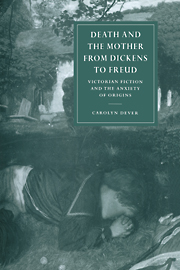Book contents
- Frontmatter
- Contents
- Preface
- 1 The lady vanishes
- 2 Psychoanalytic cannibalism
- 3 Broken mirror, broken words: Bleak House
- 4 Wilkie Collins and the secret of the mother's plot
- 5 Denial, displacement, Deronda
- 6 Calling Dr. Darwin
- 7 Virginia Woolf's “Victorian novel”
- Notes
- Index
- CAMBRIDGE STUDIES IN NINETEENTH-CENTURY LITERATURE AND CULTURE
7 - Virginia Woolf's “Victorian novel”
Published online by Cambridge University Press: 09 November 2009
- Frontmatter
- Contents
- Preface
- 1 The lady vanishes
- 2 Psychoanalytic cannibalism
- 3 Broken mirror, broken words: Bleak House
- 4 Wilkie Collins and the secret of the mother's plot
- 5 Denial, displacement, Deronda
- 6 Calling Dr. Darwin
- 7 Virginia Woolf's “Victorian novel”
- Notes
- Index
- CAMBRIDGE STUDIES IN NINETEENTH-CENTURY LITERATURE AND CULTURE
Summary
[Mr. Ramsay, stumbling along a passage one dark morning, stretched his arms out, but Mrs. Ramsay having died rather suddenly the night before, his arms, though stretched out, remained empty.]
Virginia WoolfPsychoanalytic theories of subjectivity commence with the “death” of the mother, and Victorian narratives of domesticity and Bildung are similarly invested in the prior closure that enables a clean, unimplicated beginning. This cannot be said for To the Lighthouse, a novel that begins with a mother who is not only living but present and powerful. In its engagement with the material force of that power, incarnate in life as in death, this novel refigures the central conventions of life-writing in both Victorian and psychoanalytic contexts. Virginia Woolf, returning to tropes of maternal loss, interrogates their limitations and exposes their potential, and in this return, she begins to excavate the emotional, psychological, and representational power of the domestic within the worldly practices of language and art. In To the Lighthouse, artistic vision is melancholic, and Woolf exploits narrative conventions that allow her to personate that melancholia through the death of the mother. But she refuses to capitulate to the assumption that this is the end of the story – or the beginning of another story, the relevant story.
Moving the mother's death from its conventional place at the beginning into the middle of the novel unleashes Mrs. Ramsay from the constraining opposition of life and death and suggests that this woman, as a woman and as a mother, plays a pivotal role in the stories of those around her, even as she retains a private adventure story of her own.
- Type
- Chapter
- Information
- Death and the Mother from Dickens to FreudVictorian Fiction and the Anxiety of Origins, pp. 203 - 212Publisher: Cambridge University PressPrint publication year: 1998



